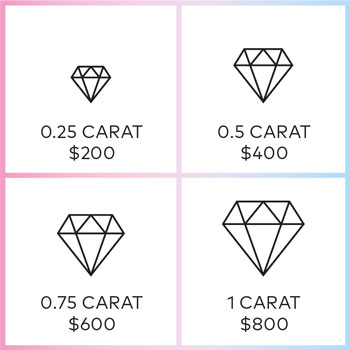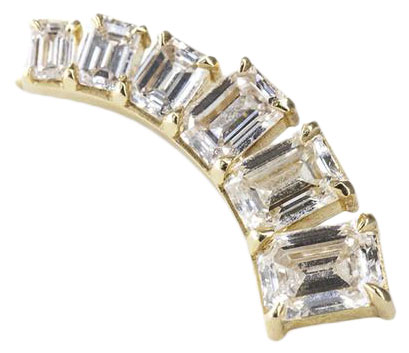Lab-made diamonds:
pricing, grading, valuation
Less than a year ago DeBeers introduced its own line of lab-made diamonds. That one step brought to the surface issues about lab-grown gems that have been percolating for some time:
How should lab-made gems be priced? What can gem-making technology achieve? Should lab-grown diamonds be graded as mined diamonds are? Does price signify quality? Are consumers being won over to lab-made diamonds—or are they being taken in? Are mined diamonds "better"? Are diamonds overpriced? What's the role of the marketplace in all this?
In this update on lab-made diamonds, we'll look at what's happening now, where current activities may lead, and how these developments affect jewelry insurers.
De Beers enters the game
"A diamond is forever." This familiar tag line, which launched the diamond engagement ring tradition, was invented by De Beers in 1948, and it meant mined diamond. For decades De Beers dominated the industry by controlling the mining and distribution of diamonds. The recent ad campaign "Real Is Rare" said with a clear voice that mined diamonds were the only "real" diamonds; gems made in a lab were not worthy of the name.
Then in 2018 De Beers began selling jewelry laden with its own lab-made diamonds under the name Lightbox, at prices well below the competition.
Priced by the carat
Lightbox diamonds are priced solely on carat weight. If a buyer knows nothing else about gems, she knows carat weight and price. It's a great consumer hook, and it really shook the lab-made industry.
Most manufacturers of lab-made diamonds have patterned their pricing on mined diamonds, though keeping their prices about 30% below mined diamonds. For mined diamonds, the per-carat price increases with gem size because fewer deposits exist for large diamonds.
De Beers sees this model as unjustified for synthesized gems. In the lab, a diamond can be grown to the desired size, so rarity is not a determinant in pricing. (Right now, 1 carat is the maximum size for Lightbox, but that is expected to change.)
At $800 a carat, a Lightbox diamond is about one-fifth the price of other lab-grown diamonds and one-tenth the price of mined diamonds of similar quality. Competitors believe that Lightbox cannot be making a profit at these prices.
De Beers' announcement had an immediate disruptive effect. Rob Bates, news director of the jewelry trade publication JCK, said, "I saw a guy selling lab-growns for $2,200 a carat at a trade show. But as soon as De Beers announced their price, he reduced his price" to $800.
The lab-grown industry has filed a complaint with the U.S. Federal Trade Commission, accusing De Beers of price dumping and predatory pricing.
"De Beers aren't stupid," said Tom Chatham of Chatham Created Gems. "They know how to grow diamonds, but this equipment is not cheap. They are selling below cost."
What about the other 3 Cs – color, clarity and cut?
For mined diamond, the 4 Cs determine quality. Is that true for lab-grown diamonds?
Mined diamonds vary a great deal in color and clarity because of the conditions under which they developed. Since lab-grown diamonds develop under controlled conditions, Lightbox says its gems are of consistent high quality. And their cutting is also standardized.
The low and simple per-carat pricing also serves De Beers' larger purpose: to instill in the consumer's mind a large gap between lab-grown and mined diamonds. On its website, Lightbox diamonds are described as "neither as valuable or precious" as mined diamonds, but "they are just as sparkly."
Lightbox diamonds are advertised as suitable for birthdays or similar light occasions — not for serious events like engagements, which remain the province of mined diamonds sold under the De Beers name.
Unlike many prominent sellers of lab-made diamonds, Lightbox does not reveal the quality grades of its stones or supply lab reports. As CEO Bruce Cleaver put it, with why-bother cheekiness: "We don't think they deserve to be graded. They're all the same."
However, here's a sneak peek:
Lightbox sells diamond jewelry, not loose diamonds, but GIA managed to obtain from a "third-party vendor" two quarter-carat Lightbox diamonds intended for earrings. GIA's evaluation revealed them to be G color grade, VS1 clarity, and of excellent and very good cut grade.
Lab Reports
All of this comes amid growing discussions about how exactly lab-grown stones should be graded. Grading labs recognize that there are color and clarity differences among lab-made diamonds, though not as wide a range of quality as for mined stones.
GIA has been offering Synthetic Diamond Reports for more than a decade. Despite GIA's high reputation for mined diamond reports, these certs are not much sought by gem sellers because they use the word synthetic—a term often taken to mean fake. In a recent change to Federal Trade Commission guidelines, synthetic is no longer a recommended term for lab-made gems (though the word may be used). So GIA may remove that word from its reports.
GIA's current reports for lab-made diamonds do not follow the grading system used for mined diamonds. Color, for example, is described in more consumer-friendly terms as "colorless," "near colorless," "faint," "very light," or "light," rather than with a letter grade.
HRD, a respected lab in Germany, has announced it will grade lab-made stones using the standard 4C grading scales. Some gemologists feel the GIA should do that as well, since a standard system allows consumers to compare apples to apples. Others argue that the traditional system, which dates from the 1950s, is due for an upgrade, preferably one more comprehensible to consumers.
There is also the issue of treatments, or enhancements, on both lab-made diamonds and mined stones. Detecting some of the current treatments, and distinguishing mined from lab-grown stones, requires examination in a grading lab that can afford the expensive technology required.
These are all big changes for grading labs that traditionally did not issue reports on lab-made stones at all. Some say such changes could lead to grading lab-grown colored stones and even moissanite. "It could even open the door to grading cubic zirconia. After all," says Rob Bates of JCK, "why grade one man-made material and not another?"
Looking to the future
The supply of mined diamonds is limited. Many of the best deposits have been mined out, and large diamonds of good quality are mostly found in the antique and auction markets.
On the other hand, given the trajectory of technology, the supply of lab-made diamonds of good quality and substantial size is virtually unlimited. What isn't available today will probably be here tomorrow. Producers in China are said to be already selling 3-carat diamonds comparable to Lightbox stones in quality and price.
Millennials are drawn to the lower price of lab-made diamonds. They also see grown diamonds as an ethical alternative to conflict diamonds, diamonds mined with forced labor and sold to finance insurgencies.
Today lab-made stones are only a small fraction of the market, but that may increase dramatically. The lower prices of lab-made stones may pressure the mined-stone market to reduce prices as well.
All of this should remind insurers, in offering coverage and in settling claims, to be sure valuations are based on the current market.
NOTE: All jewelry pictured here contains lab-made gems.
FOR AGENTS & UNDERWRITERS
Mined and lab-grown diamonds are both "real diamond," having the same chemical, physical and optical properties. But their valuations differ.
Value is determined, ultimately, by the market. New technologies and an increasing number of diamond producers mean more competition, which can put the pricing of both lab-made and mined diamonds in flux.
That's why it's important to have an appraisal from a trained gemologist appraiser who is familiar with the current market for mined and lab-made diamonds AND can identify mined from grown diamond.
The best appraisal includes the JISO 78/79 appraisal form and is written by a qualified gemologist (GG, FGA+, or equivalent), preferably one who has additional insurance appraisal training. One course offering such additional training is the Certified Insurance Appraiser™ (CIA) course of the Jewelry Insurance Appraisal Institute.
An appraisal should state that the diamond is either mined (natural) or lab-made (synthetic, lab-grown, man-made, cultured, created).
FOR ADJUSTERS
Jewelry with multiple gems may have mined and lab-grown stones mixed together. If the appraisal does not explicitly state a gem is mined, use every means possible to determine whether it is mined or lab-grown.
Be especially diligent with colored diamonds, which are very expensive for mined diamond but easily produced in the lab. Lightbox, for example, sells its pink and blue diamonds at the same price as its colorless stones.
Some lab-grown diamonds are inscribed with the name of the manufacturer, though some are not. And inscriptions on the gem's girdle can be removed. Deliberate non-disclosure is always possible.
Gem-grading labs have received parcels with lab-grown diamonds mixed in with mined gems. How many lab-made stones have not been "caught" and are out in the marketplace being sold, and priced, as mined diamonds? The potential for overpayment on claims is enormous.
Be alert for fraud. Disclosure information can get "lost." A customer may buy jewelry with lab-made diamonds, not understanding the meaning of a term like cultured, for example, or not appreciating the large difference in value between mined and grown diamond. When he becomes aware that he made a bad purchase, he may "sell" it to the insurance company through a fraudulent claim.
©2000-2025, JCRS Inland Marine Solutions, Inc. All Rights Reserved. www.jcrs.com








